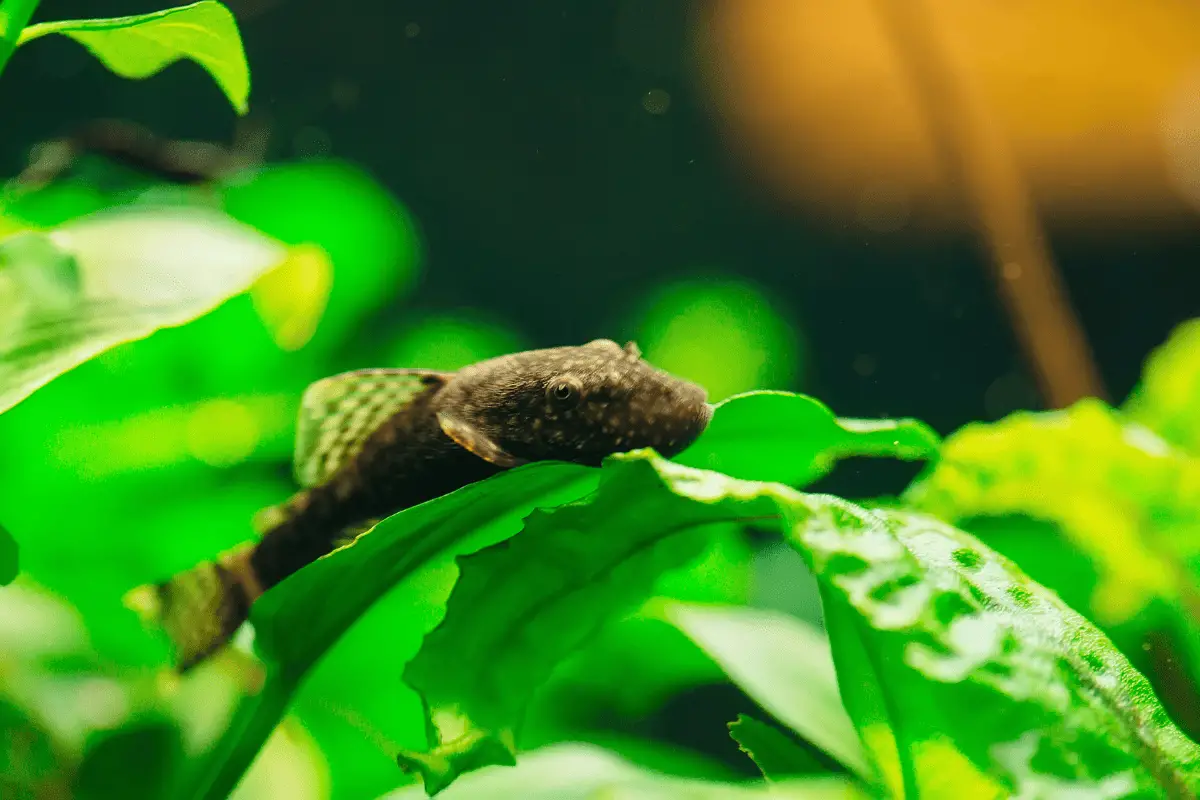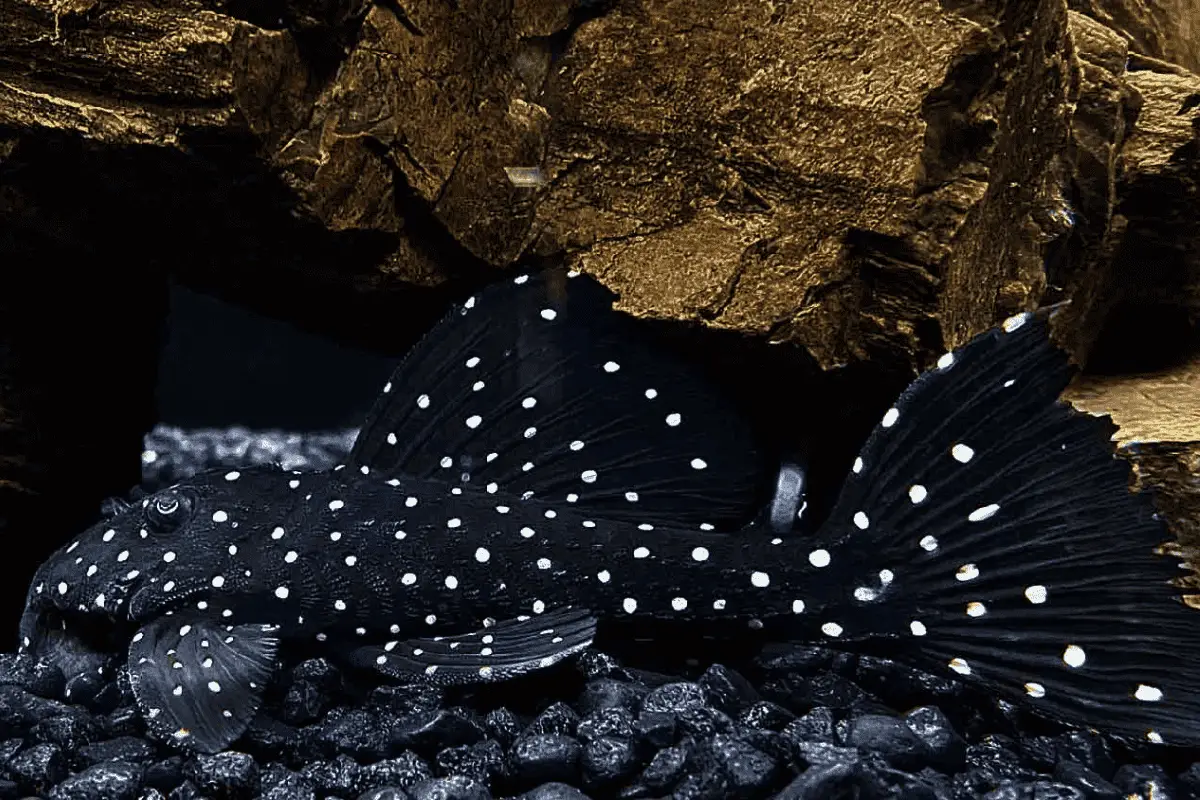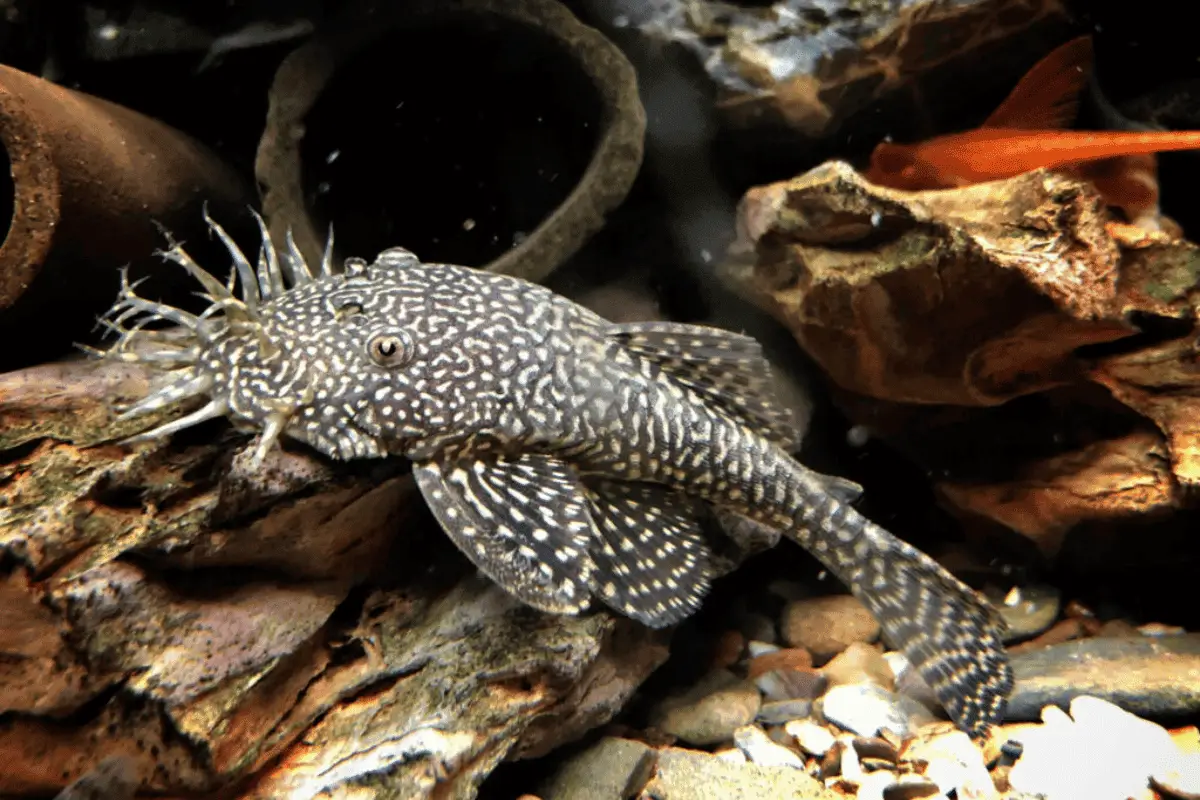When my dad and I started with our fish tank, we wondered about the right temperature for our Plecos. Over time, we learned a lot through experience and research.
Realizing that others might have the same questions, I decided to write this article to share everything I know about the ideal temperature for Plecos.
So, without further ado, let’s get started.

What’s the Right Water Temperature for Plecos?
Plecos thrive best in water temperatures ranging from 74°F to 80°F (23°C to 27°C). Maintaining this temperature range ensures their optimal health and well-being.
- Natural Habitat Conditions: Plecos come from South American rivers where temperatures usually stay between 74°F to 80°F, mimicking their native conditions.
- Metabolic Efficiency: At 74°F to 80°F, Plecos’ metabolism is efficient, aiding proper digestion and growth; deviations can hamper these processes.
- Disease Prevention: Maintaining the recommended temperature range decreases the risk of diseases in Plecos, ensuring longer, healthier lives.
- Behavior and Comfort: Plecos show natural and stress-free behaviors when kept in their ideal temperature range, contributing to overall well-being.
For a better understanding, here’s a breakdown of the desired water temperatures for different Plecos species:
| Pleco Species | Desired Temperature |
| Common Pleco (Pterygoplichthys) | 72-86°F (22-30°C) |
| Bristlenose Pleco (Ancistrus) | 72-78°F (22-25.5°C) |
| Zebra Pleco (Hypancistrus zebra) | 79-86°F (26-30°C) |
| Clown Pleco (Panaqolus maccus) | 76-82°F (24.5-27.5°C) |
| Rubber Lip Pleco (Chaetostoma) | 70-78°F (21-25.5°C) |
| Gold Nugget Pleco (Baryancistrus) | 75-81°F (24-27°C) |
| Snowball Pleco (Hypancistrus) | 73-79°F (23-26°C) |
| Butterfly Pleco (Dekeyseria) | 75-82°F (24-27.5°C) |
| Vampire Pleco (Leporacanthicus) | 79-84°F (26-29°C) |
| King Tiger Pleco (Hypancistrus) | 73-79°F (23-26°C) |
| Blue Phantom Pleco (Hemiancistrus) | 73-82°F (23-27.5°C) |
| Green Phantom Pleco (Baryancistrus) | 75-86°F (24-30°C) |
| Spotted Pleco (Pterygoplichthys) | 74-80°F (23.5-26.5°C) |
| Sailfin Pleco (Pterygoplichthys) | 74-80°F (23.5-26.5°C) |
| Royal Pleco (Panaque) | 72-78°F (22-25.5°C) |
| Sunshine Pleco (Scobinancistrus) | 79-84°F (26-29°C) |
| Galaxy Pleco (Leporacanthicus) | 79-84°F (26-29°C) |
| Mango Pleco (Pseudancistrus) | 72-79°F (22-26°C) |
| Medusa Pleco (Ancistrus ranunculus) | 70-76°F (21-24.5°C) |
| Peppermint Pleco (Parancistrus) | 75-81°F (24-27°C) |
Also Read: Plecos Water Parameters

What’s the Minimum Water Temperature for Plecos?
The minimum water temperature for Plecos is typically around 72°F (22°C). Temperatures below this can stress the fish and negatively impact their health.
It’s essential to keep them in conditions close to their natural habitat for optimal well-being.
How Does Cold Water Affect Plecos?
Although Plecos can tolerate cold water, it is not ideal. Here’s what might happen:
1. Slower Growth
Cold water can significantly reduce the growth rate of Plecos. As their metabolic rate slows down in cooler conditions, they might not grow at their optimal rate.
- Metabolic Deceleration: Plecos in colder waters experience a slower metabolism, leading to reduced energy and cellular activities that support growth.
- Comparison with Optimal Conditions: In ideal temperatures (74°F to 80°F), Plecos can grow rapidly, whereas prolonged exposure to colder temperatures can stunt their growth.
- Adverse Environmental Impact: Continual exposure to temperatures below their comfort range can permanently affect Plecos’ growth trajectory, leading to undersized adults.

2. Less Interest in Breeding
Colder water temperatures can deter Plecos from breeding. The reproductive behavior and processes can be severely hampered, affecting the population’s expansion.
- Natural Breeding Cues: In their native habitats, specific temperature ranges signal Plecos that conditions are right for breeding; colder temperatures lack this cue.
- Energy Conservation: In cold environments, Plecos are more likely to conserve energy rather than expend it on reproductive efforts.
- Egg Viability: Even if Plecos breed in colder temperatures, the viability and survival rate of the eggs can be compromised.
3. Higher Risk of Getting Sick
Cold water weakens the immune system of Plecos, making them more susceptible to illnesses and diseases.
- Stress Induced: Colder temperatures can stress Plecos, which in turn weakens their immune responses to pathogens.
- Pathogen Proliferation: Some diseases and pathogens thrive in colder waters, posing a direct threat to Plecos.
- Long-term Impact: Chronic exposure to cold can leave Plecos in a persistently weakened state, increasing the risk of multiple ailments over time.

4. Reduced Swimming Ability
In cold water, Plecos’ muscle functions are not as efficient, reducing their agility and swimming capability.
- Muscular Slowdown: Cold temperatures affect muscle contractility in Plecos, leading to slower and less coordinated movements.
- Energy Conservation: With reduced metabolism in the cold, Plecos may minimize movements to save energy.
- Environmental Challenges: Hindered swimming abilities can make Plecos more vulnerable to environmental threats, such as strong currents or predators.
5. Loss of Hunger
Cold water can diminish the appetite of Plecos, leading to less frequent feeding and possible malnutrition.
- Metabolic Link: Since metabolism slows in colder temperatures, Plecos require less food and thus display reduced hunger.
- Digestive Challenges: The efficiency of the digestive system is compromised in cold conditions, making Plecos less inclined to feed.
- Nutritional Deficits: Prolonged lack of appetite can lead to nutritional deficiencies in Plecos, affecting their overall health and vitality.

What’s the Maximum Water Temperature for Plecos?
The maximum water temperature for Plecos is generally around 86°F (30°C). Exceeding this limit can cause stress and adverse health effects for the fish.
- Oxygen Levels: Warmer waters hold less dissolved oxygen, which is vital for Plecos; reduced oxygen can lead to respiratory distress and lethargy in these fish.
- Metabolic Overdrive: While Plecos’ metabolism increases with temperature, excessively warm waters can push their systems into overdrive, leading to rapid energy consumption and potential health risks.
- Disease Susceptibility: Elevated temperatures can promote the growth of harmful pathogens and bacteria, making Plecos more prone to diseases and infections in warmer conditions.
What to Do if Your Pleco Tank Water Is Too Warm
If the water in your Pleco fish tank gets too hot, here are some actions you can take:
1. Boost Oxygen Levels
When tank water heats up, oxygen levels drop, making it necessary to enhance the amount of dissolved oxygen for Plecos. Implementing an air pump or airstone can mitigate this.
- Dissolved Oxygen Depletion: In warmer water, oxygen can drop below 5 mg/L, dangerous for Plecos who thrive at 6-8 mg/L.
- Air Pump Efficiency: Using an air pump rated appropriately for the tank size (e.g., a 200 GPH pump for a 50-gallon tank) can optimize oxygen dispersion.
- Regular Monitoring: Invest in a reliable oxygen test kit to routinely check levels, ensuring Plecos have a conducive environment.

2. Use a Fan for Cooling
Positioning a fan to blow across the water’s surface can induce evaporative cooling, effectively reducing the tank’s temperature for the comfort of Plecos.
- Evaporative Cooling Principle: Fans can lower the water temperature by 2-4°F, depending on the room’s ambient temperature and fan speed.
- Fan Selection: Opt for an adjustable, oscillating fan to evenly distribute the cooling effect across the tank.
- Safety Precaution: Ensure electrical components are protected from potential water splashes to avoid accidents.
3. Apply an Ice Pack
Gently placing frozen packs or bottles in the tank can help bring down water temperatures quickly for Plecos.
- Temporary Solution: This method can reduce the temperature by 1-3°F; monitor with a thermometer and replace packs as needed.
- Safe Usage: Use plastic bottles filled with water and frozen, ensuring there’s no direct contact with fish and no chemicals leach into the water.
- Gradual Introduction: Slowly introduce the frozen packs to prevent abrupt temperature changes which can shock Plecos.
4. Change the Water
Regularly replacing a small portion of the tank water with cooler water can maintain a stable temperature for Plecos.
- Partial Water Changes: Swap out 10-15% of the water with cooler (but not cold) water to balance temperatures without causing stress.
- Temperature Consistency: Use a thermometer to ensure the new water is only a few degrees cooler than the tank water.
- Frequency: Depending on the severity of the heat, this can be done daily or every few days until conditions stabilize.

5. Adjust Heater Settings
Ensure the aquarium heater is set correctly, and if it’s malfunctioning, it might be raising the water temperature for Plecos.
- Thermostat Check: Most heaters have adjustable thermostats; make sure it’s set between 74°F to 80°F for optimal Pleco health.
- Calibration: Occasionally calibrate your heater with an independent thermometer to verify accuracy.
- Replacement: If the heater is consistently overheating, consider replacing it with a reliable, well-reviewed brand.
6. Turn Off the Lights
Excessive lighting, especially if it’s strong or left on for prolonged periods, can raise tank temperatures, affecting Plecos.
- Lighting Duration: Limit light exposure to 8-10 hours a day, and consider using a timer to automate the process.
- LED Options: Switch to LED lights, which emit less heat compared to incandescent or halogen bulbs.
- Natural Light Caution: Position the tank away from direct sunlight, as this can rapidly increase water temperatures, endangering Plecos.

Do Plecos Require a Heater?
Yes, Plecos do require a heater in their aquariums. Maintaining a consistent, warm temperature is crucial for their health and well-being.
- Tropical Beginnings: Plecos hail from South American rivers with a constant temperature of 74°F to 80°F. So, they need similar environments when kept in captivity.
- Health Factors: The right temperature ensures that Plecos maintain a healthy metabolism, supporting digestion, growth, and overall vigor.
- Avoiding Illness: Using a heater can stave off unexpected temperature shifts. Sudden changes can stress Plecos, making them prone to illness.
My recommendation: Fluval E300 Advanced Heater (link to Amazon).
Maintaining Water Temperature During Water Changes for Plecos
Ensuring a stable water temperature during changes is essential for Plecos. Sudden shifts can stress them, potentially harming their health.
- Thermometer Use: Always rely on a trustworthy aquarium thermometer to align the new water temperature with the current tank water, ideally with a 1-2°F difference.
- Preparing Water: Before introducing new water, allow it to settle to room temperature, or utilize a heater to suit the Plecos’ needs.
- Steady Additions: Pour in the new water bit by bit instead of all at once to avoid quick temperature swings in the tank.
- Post-change Checks: Monitor the water temperature continuously for several hours after the change, making tweaks if needed for the Plecos’ benefit.

Can Plecos Thrive in an Outdoor Pond?
Yes, Plecos can inhabit outdoor ponds, but it’s crucial to maintain specific conditions, primarily temperature, for their health.
Their tropical background means they favor warmer waters outside.
- Stable Temperatures: Outdoor ponds should always have water temperatures ranging from 74°F to 80°F for the Plecos’ comfort and health.
- Seasonal Precautions: In areas with colder seasons, outdoor pond temperatures could fall beneath the safe range, posing a threat to Plecos.
- Monitoring Systems: Installing a reliable pond thermometer and potentially a heating system can help monitor and maintain optimal temperatures for Plecos in an outdoor setting.
Best Water Temperature for Breeding Plecos
The ideal water temperature for breeding Plecos lies slightly above their normal range, typically between 78°F to 82°F.
This warmer environment stimulates breeding behavior and ensures successful reproduction.
- Breeding Triggers: Elevating the temperature within this range can act as a cue, signaling to Plecos that conditions are favorable for breeding.
- Egg Viability: A temperature between 78°F to 82°F ensures Pleco eggs have a higher rate of viability, leading to better hatch rates.
- Health of Fry: Post-hatching, the warmer environment supports the growth and development of Pleco fry, promoting healthier offspring.
When Should You Introduce Plecos to Warmer Water?
Plecos should be introduced to warmer water during breeding or when you notice signs of lethargy, possibly due to cooler water conditions.
Maintaining an optimal temperature range enhances their overall health and activity levels.
- Breeding Stimulation: Plecos, when exposed to temperatures between 78°F to 82°F, are more inclined to breed, with this warmth mimicking their natural breeding conditions.
- Metabolic Boost: Warm water promotes a healthy metabolism in Plecos, aiding in better digestion and nutrient absorption.
- Counteracting Lethargy: If Plecos appear sluggish or inactive, slightly warmer water can rejuvenate them and improve their activity levels.
- Stress Reduction: Plecos, when gradually introduced to a warmer environment after being in cooler conditions, exhibit reduced stress levels and better overall behavior.
- Disease Recovery: Warmer waters can assist Plecos in recovering faster from certain illnesses, as some pathogens are less virulent at higher temperatures.

How to Place a Pleco Fish Tank to Prevent Temperature Changes
Positioning a Pleco fish tank in a stable temperature environment away from direct sunlight and drafts is critical.
Such placement ensures consistent water conditions, promoting the health of Plecos.
- Avoid Direct Sunlight: Direct sunlight can cause rapid temperature fluctuations; hence, placing the tank away from windows or sunlit areas is essential for Plecos.
- Steer Clear of Vents and Radiators: Heat sources or air-conditioning vents can drastically alter the tank’s temperature, stressing Plecos.
- Stable Room Temperature: Place the Pleco tank in a room with a consistent ambient temperature, ideally between 70°F to 75°F, to maintain water stability.
- Use of Insulating Materials: Consider using tank insulators or backing materials that can shield the tank from sudden temperature variations, further ensuring Plecos’ comfort.
Additional Water Requirements for Plecos
Apart from temperature, it’s crucial to maintain the pH and water hardness within the correct parameters:
1. pH Levels
The right pH level is crucial for the health and wellness of Plecos. To replicate their natural environment, it’s key to keep the pH slightly acidic to neutral.
- Ideal Range: Plecos do best in a pH range between 6.5 and 7.5, reflecting the tropical rivers of their origin. I personally use the API FRESHWATER MASTER TEST (link to Amazon).
- Regular Monitoring: With a trustworthy pH test kit, check the tank’s pH frequently to ensure it stays in the best zone for Plecos.
- pH Adjusters: If the pH strays from the target range, use pH up or down adjusters made for aquariums to get the right balance for Plecos.
Also Read: Best pH For Plecos

2. Water Hardness
Water hardness, which refers to the concentration of calcium and magnesium in the water, impacts the overall well-being of Plecos.
Soft to moderately hard water is typically best suited for these fish.
- Natural Habitat Conditions: In their natural habitats, Plecos are accustomed to soft to moderately hard water, typically ranging from 4 to 15 dGH (degrees of General Hardness).
- Effects on Plecos: Extremely hard or soft water can lead to stress and potential health problems in Plecos, affecting their scales, gills, and overall bodily functions.
- Water Conditioning: Using water conditioners or introducing specific substrates and decorations (like driftwood) can help in adjusting and maintaining the water hardness ideal for Plecos.

Conclusions
For those of you in a hurry, here’s a short summary of what I discussed earlier:
- Plecos thrive in water temperatures between 74°F to 80°F, mirroring their natural habitat.
- Cold water negatively impacts Plecos, slowing growth, reducing breeding interest, increasing disease susceptibility, hindering swimming, and diminishing appetite.
- Exceeding 86°F stresses Plecos, reducing oxygen, causing metabolic overdrive, and increasing disease risk.
- Consistent temperature is vital, matching water temperatures during changes, and gradual introduction prevents stress.
- For breeding, maintain 78°F to 82°F, and place tanks away from direct sunlight and drafts to ensure stable conditions.
